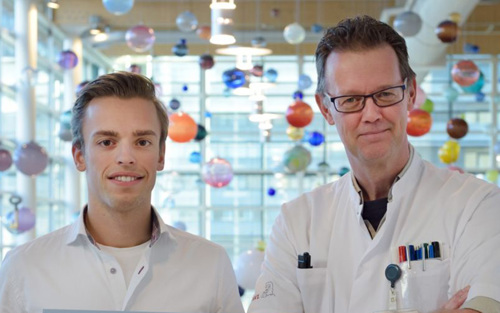Less radiotherapy required, so fewer complications with rare sarcoma
12 Nov 2020 16:22
Myxoid Liposarcoma (MLS) is a very rare type of cancer. Only about two in every million people are diagnosed with MLS each year. This makes it extremely difficult to find the numbers of patients – and the funding – needed for clinical trials aimed at improving treatment methods for this disease.
And yet, radiation oncologist Rick Haas did manage to set up an international trial, which showed that these patients can be treated effectively with less radiotherapy. The trial conducted by Prof. Haas and his team showed that the number of radiation sessions could safely be reduced from 25 to 18.

This halves the risk of wound complications, and fewer patients need further surgery. In addition, the course of radiotherapy requires seven fewer hospital visits than before. Aside from the benefits associated with making treatment less stressful for patients, this ‘less where possible’ approach helps to keep oncological care affordable.
The researchers, with clinical research physician Jules Lansu as first author, will publish these results on 12 November, in the prestigious journal JAMA Oncology.
J. Lansu et al., Dose Reduction of Preoperative Radiotherapy in Myxoid Liposarcoma. JAMA Oncology, 12 November 2020
Myxoid Liposarcoma
Sarcomas or soft tissue tumors are a group of rare tumors. There are more than 50 different subtypes, which differ widely in their behavior and in their sensitivity to treatments. One of these subtypes is Myxoid Liposarcoma, which usually originates from fat cells in the thigh. The swelling is located between the large muscles and beneath the layer of subcutaneous fat, so it doesn’t immediately cause symptoms. As a result, these tumors grow to an average diameter of around 10 centimeters before the disease is diagnosed. MLS mainly occurs in young people. Most patients are aged around 40.
What makes MLS unusual is that these tumors are particularly sensitive to radiotherapy, unlike almost every other type of sarcoma. These patients are given radiotherapy to reduce the risk of local tumor recurrence, usually as a prelude to surgery.
Can we reduce the radiotherapy dose?
Sadly, in more than a third of cases, radiotherapy produces unpleasant side effects that can hinder the patient’s recovery. For instance, there may be an increased risk of wound complications after surgery.
In 2010, that prompted radiotherapist Rick Haas to launch a nine-center international trial. The aim was to find out whether the radiotherapy dose for this radiosensitive subtype could safely be reduced. This year, in addition to his role at the Netherlands Cancer Institute, Prof. Haas took up a professorial post at the Leiden University Medical Center.
The trial’s results are now in, and the details will be published on 12 November, in the journal JAMA Oncology. ‘The results of this trial were everything we could have hoped for’, says clinical research physician and first author Jules Lansu, whose PhD project is part of this trial. ‘We saw that the risk of local recurrence was no greater than what we had seen in the past with the old, higher dosage treatment. At the same time, the risk of wound complication was halved.’
‘You’ll get sued’
Ten years ago, many questioned the wisdom of conducting a trial to find out whether this group of patients could manage with fewer radiotherapy sessions: ‘How could I have the audacity to expose patients to a potentially greater risk of recurrence?’ Some of my professional counterparts in America assured me that ‘You’ll get sued!’. Yet, one of the most prestigious American cancer centers the Dana Farber Cancer Institute, decided to become a partner in the study. Also, our own Medical Ethics Committee insisted that an extra paragraph be inserted into the patient information form.’
Yet his scientific observations and his observations of patients gave him the confidence to design a clinical trial and to invite various international sarcoma centers to get involved. The patients themselves began to notice that, after the third week of irradiation, their tumors started shrinking. Prof. Haas adds that ‘We saw the same thing in our scans. Furthermore, after six to eight weeks, our examinations of residual tumor tissue under the microscope showed that almost no living tumor cells remained.’
Next steps
Rick Haas explains that two follow-up steps are required. First of all, after a trial of this kind, it is customary for the international guidelines to be modified. The European Society for Medical Oncology does this every two years.
Secondly, more knowledge is needed. However, it has taken the DOREMY (Dose Reduction of Preoperative Radiotherapy in Myxoid Liposarcomas) trial nearly a decade to find just 79 patients. Rick Haas notes that ‘This is such a rare disease that it will never be possible to set up a randomized phase III trial. But, of course, we are always keen to learn more. So, from now on, everyday practice will be our teacher.’ With this in mind, he is asking every sarcoma center in the world to register its data in a central registration system.
Fortunately, these centers are already cooperating closely with one another. Jules Lansu remarks that ‘This trial would never have been possible without intensive worldwide cooperation between leading sarcoma centers, such as the Netherlands Cancer Institute.’
Read more:
- Sarcomas (avl.nl)
- The DOREMY trial (Dose Reduction of Preoperative Radiotherapy in Myxoid Liposarcomas)
- Radiotherapist Rick Haas is now a professor in Leiden
- Rick Haas
- Jules Lansu
- Patiëntenplatform Sarcomen (Sarcoma Patient Platform)
- Connective Tissue Oncology Society
 nl
nl
 Nederlands
Nederlands